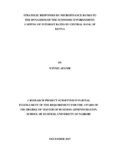| dc.contributor.author | Afandi, Winnie | |
| dc.date.accessioned | 2018-01-22T06:50:46Z | |
| dc.date.available | 2018-01-22T06:50:46Z | |
| dc.date.issued | 2017 | |
| dc.identifier.uri | http://hdl.handle.net/11295/102472 | |
| dc.description | A Research Project Submitted in Partial Fulfillment of the Requirement for the Award of the Degree of Master of Business Administration, School of Business, University of Nairobi | en_US |
| dc.description.abstract | The business environment is highly dynamic posing various opportunities and threats to organizations. Strategic realignments are therefore inevitable in the current business environment. Organizations are tasked to continuously scan and assess the internal and external environment and develop appropriate strategies to survive and remain competitive amidst the changes in the environment. The banking sector has undergone a paradigm because of many changes in the economic environment affecting their performance. The microfinance banks meant to support the SMEs have faced the ripple effect of capped interest rates by the Central Bank of Kenya. This research sought to determine the strategic responses by microfinance banks to the dynamism in the economic environment with specific focus on the capping of interest rates by the CBK. The research also sought to determine the impact of capping of interest rates on performance of MFBs. The resources and dynamic capabilities that influence strategic responses were also established. A cross-sectional survey of all the thirteen licensed microfinance banks as at the end of 30th June, 2016 was undertaken. A semi-structured questionnaire was administered to the heads of strategy and equivalents at the headquarters of the microfinance banks using drop and pick technique. Data analysis was undertaken using descriptive statistics to address the objectives of the study. Findings of the study indicated increase in loan applications and reduction in number of successful loan applications as the main ways in which performance of MFBs was affected. In addition, MFBs experienced a flight of high-end customers to commercial banks. Technological innovations and exemplary customer service were the main capabilities that spearheaded strategic orientation towards the capping of interest rates by CBK. The strategies pursued as revealed by this research included secure lending, innovation, diversification, focus and investment into new markets. Microfinance banks need to expand on market intelligence to cover the untapped markets and increase market share given the opportunities in the economic environment. Full implementation of secure lending will seemingly reduce financial inclusion of SMEs. This would open windows for illegal lending which poses tough times for low-income earners. There is need for policy reviews to remedy such outcome. Microfinance banks need to continue to invest in dynamic capabilities and continuously assess the economic environment as a competitive advantage. In addition, successful strategic responses will require commitment of available resources and capabilities. | en_US |
| dc.language.iso | en | en_US |
| dc.publisher | University of Nairobi | en_US |
| dc.rights | Attribution-NonCommercial-NoDerivs 3.0 United States | * |
| dc.rights.uri | http://creativecommons.org/licenses/by-nc-nd/3.0/us/ | * |
| dc.title | Strategic Responses by Microfinance Banks to the Dynamism of the Economic Environment: Capping of Interest Rates by Central Bank of Kenya | en_US |
| dc.type | Thesis | en_US |



